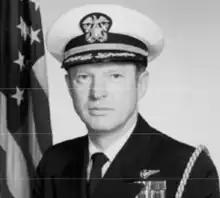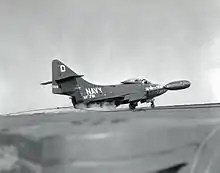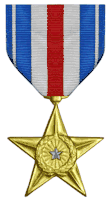Elmer Royce Williams | |
|---|---|
 Williams in 1973 | |
| Nickname(s) | Royce |
| Born | 4 April 1925 Wilmot, South Dakota, U.S. |
| Service/ | |
| Years of service | 1943–1980 |
| Rank | Captain |
| Commands held | USS Eldorado |
| Known for | Downing four Soviet MiG-15s in one engagement during the Korean War |
| Battles/wars | Korean War Vietnam War |
| Awards | |
| Alma mater | University of Minnesota |
Elmer Royce Williams[1] (born 4 April 1925)[2] is a retired United States naval aviator. He is known for his solo dogfight with seven Soviet pilots during the Korean War, which, according to The San Diego Union-Tribune, has been called "one of the greatest feats in aviation history" by military experts.[3] A retired admiral and multiple members of Congress have been campaigning for him to receive the Medal of Honor for his exploit. On January 20, 2023, he received the Navy Cross—the highest military decoration awarded by the U.S. Navy—from Secretary of the Navy Carlos Del Toro.
Early life and military career
Royce Williams grew up in Wilmot, South Dakota.[2] He and his brother both aspired to fly, and both enlisted after the 1941 Pearl Harbor attack. Williams remained in the Navy while attending college in Minnesota, and qualified as a naval aviator at Pensacola in August 1945.[4] He learned to fly the F9F-5 Panther jet and was assigned to active duty in the Korean War, where he flew 70 missions.[3]

In 1952, then-Lieutenant Williams was serving with VF-781 aboard the USS Oriskany as part of Task Force 77. On 18 November 1952, on his second mission of the day, while on combat air patrol near Hoeryong, North Korea, his group of four pilots spotted seven MiG-15s overhead. The other three pilots had to return to the carrier and the MiGs began to fire on Williams, putting him into a one-man dogfight with seven MiG-15s that lasted 35 minutes.[5] It is believed to be the longest dogfight in U.S. Navy history.[3] Commanders on his carrier ordered him away, but Williams had to tell them that he was already fighting for his life.[6] He shot down four of the MiGs and likely hit two others.[7] By the end of the 35-minute period, only one of the MiGs was still in the air with him, and he managed to escape back to his carrier, out of ammunition and having lost his hydraulics. He was uninjured, but 263 holes were counted in his Panther jet. He never saw the plane again; reportedly, it was pushed into the sea.[5]
The story of his battle with the Soviet-piloted MiGs led to Williams being debriefed at the time by admirals, the Secretary of Defence, and a few weeks later by newly inaugurated President Dwight D. Eisenhower.[6] These authorities made a decision to cover up the specifics of the battle, because at that time the Soviet Union was not officially a combatant in the Korean War and it was feared that publicity about the air battle would draw the Soviets further into the conflict. The dogfight was scrubbed from U.S. Navy and National Security Agency records, and Williams was sworn to secrecy about the incident—so much so that he never told anyone about it, not even his wife nor his pilot brother, until the Korean War records were declassified in 2002.[3] The record of the incident in Navy records said only that he shot down one enemy (not listed as "Soviet")[6] plane and damaged another, for which he was awarded the Silver Star in 1953.[8] However, the dogfight was recorded in Soviet archives which were released after the fall of the Soviet Union in the 1990s. The Soviet records confirmed that of the seven MiGs, only one returned to its base.[7] A 2014 Russian book, Red Devils over the Yalu: A Chronicle of Soviet Aerial Operations in the Korean War 1950–53, reported the battle and named Williams.[9] The four MiGs were flown by Soviet Naval Aviation pilots, with Captains Belyakov and Vandalov, and Lieutenants Pakhomkin and Tarshinov being shot down. In his book Holding the Line about Task Force 77, Thomas McKelvey Cleaver described the fight, saying "On November 18, 1952, Royce Williams became the top-scoring carrier-based naval aviator and the top-scoring naval aviator in a Navy jet of the 'forgotten war'." He added, "In the fight of his life, Royce Williams had accomplished what no other American fighter pilot would ever accomplish: shoot down four MiG-15s in one fight."[4]
Between 1965 and 1967, he flew 110 missions in A-4 Skyhawks and F-4 Phantoms from the aircraft carrier USS Kitty Hawk during the Vietnam War.[10] Williams was the commanding officer of the command ship USS Eldorado between September 1969 and January 1971.[1] He retired from the Navy as a captain in 1980. In retirement, he lives in Escondido, California.[7]
Medal of Honor campaign
There has been a years-long campaign to award Williams the Medal of Honor for his exploit. In 2014, retired Rear Admiral Doniphan Shelton became aware of Williams's feat, and he tried unsuccessfully for years to get the Navy or Department of Defense to recommend him for the medal. He said that Williams's heroism was "unmatched either in the Korean War, the Vietnam War, or since then".[11] On 14 July 2022, a bipartisan group of five congressmembers persuaded the House of Representatives to approve an amendment to the Defense Authorization Act which would award the medal to Williams. The amendment and bill were approved, which were then forwarded to the United States Senate.[12][7] In 2021, one veteran who helped Shelton with his quest believed that there was still only a 75 percent chance of the medal being awarded; the key problem is that the dogfight is not recorded in official U.S. records.[3]
In January 2023 Williams was awarded the Navy Cross as an upgrade of the Silver Star the Navy awarded him in 1953.[13] The award was approved by U.S. Secretary of the Navy Carlos Del Toro, who said, "Having reviewed the findings of now numerous investigations related to the case of Capt. Royce Williams, I have determined this case to be special and extraordinary. His actions clearly distinguished himself during a high-risk mission and deserve proper recognition."[14]
Awards and decorations
His medals include the Navy Cross, the Silver Star, two Distinguished Flying Crosses and the Legion of Merit with Combat "V".[2][10]
| Navy Cross[13] | |
| Silver Star (Upgraded to Navy Cross [13]) | |
| Legion of Merit with Combat "V" | |
| Distinguished Flying Cross with 5⁄16" Gold Star | |
| Bronze Star Medal | |
| Meritorious Service Medal with 5⁄16" Gold Star | |
| Air Medal with four 5⁄16" Gold Stars and Strike/flight numeral 6 | |
| Navy and Marine Commendation Medal with Combat "V" | |
| Navy Unit Commendation with 3⁄16" Bronze Star | |
| Navy Meritorious Unit Commendation | |
| American Campaign Medal | |
| World War II Victory Medal | |
| Navy Occupation Service Medal with 'Japan' clasp | |
| China Service Medal | |
| National Defense Service Medal with 3⁄16" Bronze Star | |
| Korean Service Medal with three 3⁄16" Bronze Stars | |
| Vietnam Service Medal with four 3⁄16" Bronze Stars | |
| Republic of Korea Presidential Unit Citation | |
| Taeguk Order of Military Merit[15] | |
| Republic of Vietnam Gallantry Cross Unit Citation | |
| United Nations Service Medal for Korea | |
| Vietnam Campaign Medal | |
| Korean War Service Medal | |
Silver Star citation

- Williams, Elmer R.
- Lieutenant, U.S. Navy
- Fighting Squadron 781 (VF-781), USS Oriskany (CVA-34)
- Date of Action: 18 November 1952
- Citation:
The President of the United States of America takes pleasure in presenting the Silver Star to Lieutenant Elmer Royce Williams, United States Navy, for conspicuous gallantry and intrepidity in action while leading in aerial flight a division of three jet fighter planes attached to Fighter Squadron SEVEN HUNDRED EIGHTY-ONE (VF-781), embarked in the U.S.S. ORISKANY (CVA-34), in Korea, on 18 November 1952. While flying a combat patrol mission over Task Force 77 in the northeastern coastal waters of enemy-held North Korea, Lieutenant Williams demonstrated outstanding courage by placing himself and his accompanying planes between the Task Force and an attacking group of seven enemy MiG-15 aircraft, thereby protecting the Task Force from enemy attack. Having repelled the initial attack of enemy aircraft, he skillfully maneuvered his plane into position where he was able to make two firing passes on one of the enemy fighters. Breaking away after the second pass, he saw the enemy aircraft spiral into the sea. On a subsequent run he inflicted heavy damage to another enemy aircraft which was seen to smoke badly and retire immediately from action. Although his own plane was severely damaged by a direct 23-mm. hit from one enemy MiG-15 aircraft, he maneuvered to escape yet continued his direction of the engagement until he reached cloud cover in which he dodged the enemy and returned his almost uncontrollable aircraft on board the parent carrier. This skill and daring exhibited by Lieutenant Williams and his complete disregard for his own personal safety materially aided the accomplishment of the mission of the Task Force. His courageous actions were at all times in keeping with the highest traditions of the United States Naval Service.[16]
In popular culture
In 2020, a 20-minute documentary, Actions Speak Louder Than Medals – the Royce Williams Story, directed by John Mollison, was screened at the GI Film Festival, San Diego.[17]
References
- 1 2 "Amphibious Force Command Ship Photo Index AGC-11 Eldorado". NavSource Naval History. Retrieved 16 July 2022.
- 1 2 3 4 5 Kragen, Pam (17 June 2022). "Secret hero of the Navy's greatest solo air battle is from Escondido. Will he finally get his Medal of Honor?". San Diego Union Tribune. Retrieved 15 July 2022.
- 1 2 Cleaver, Thomas McKelvey (2019). Holding the Line: The Naval Air Campaign in Korea. Osprey Publishing. ISBN 978-1-4728-3172-9.
- 1 2 Hauptman, Max (24 June 2022). "The real-life Maverick who took on 7 Soviet jets in a classified Korean War dogfight". Task & Purpose. Retrieved 16 July 2022.
- 1 2 3 Lendon, Brad (20 January 2023). "US pilot shot down four Soviet MiGs in 30 minutes -- and kept it a secret for 50 years". CNN. Retrieved 20 January 2023.
- 1 2 3 4 "House Votes to Grant Medal of Honor to Escondido's 'Forgotten' Korean War Ace". Times of San Diego. 15 July 2022. Retrieved 15 July 2022.
- ↑ "Hall of Valor". Military Times. Retrieved 17 July 2022.
- ↑ Seidof, Igor (2013). Red Devils over the Yalu: A Chronicle of Soviet Aerial Operations in the Korean War 1950-53. Translated by Britton, Stuart. Helion & Company. ISBN 978-1-909384-41-5.
- 1 2 "E. Royce Williams, Captain, USN (Ret.)" (PDF). epnaao.com. Retrieved 26 October 2022.
- ↑ Leone, Dario (29 May 2020). "Medal of Honor sought for US Korean War F9F Naval Aviator who shot down 4 Soviet MiG-15s in a single top-secret dogfight". The Aviation Geek Club. Retrieved 16 July 2022.
- ↑ "House Nominates Former US Naval Aviator With Impressive Dogfight Story for Medal of Honor". NBC San Diego. 15 July 2022. Retrieved 31 October 2022.
- 1 2 3 "SECNAV Awards Navy Cross to Retired Korean War Veteran". U.S. Navy. 21 December 2022. Retrieved 8 January 2023.
- ↑ Wilkens, John (13 January 2023). "Secret hero of Korean War air battle to receive Navy Cross". San Diego Union Tribune. Retrieved 16 January 2023.
- ↑ Nam, Hyun-woo (26 April 2023). "Yoon awards top military medals to Korean War heroes". The Korea Times. Retrieved 5 January 2024.
- ↑ "Elmer Williams". Military Times of Valor. Retrieved 26 October 2022.
- ↑ "Actions Speak Louder Than Medals – the Royce Williams Story". GI Film Festival San Diego. Retrieved 16 July 2022.